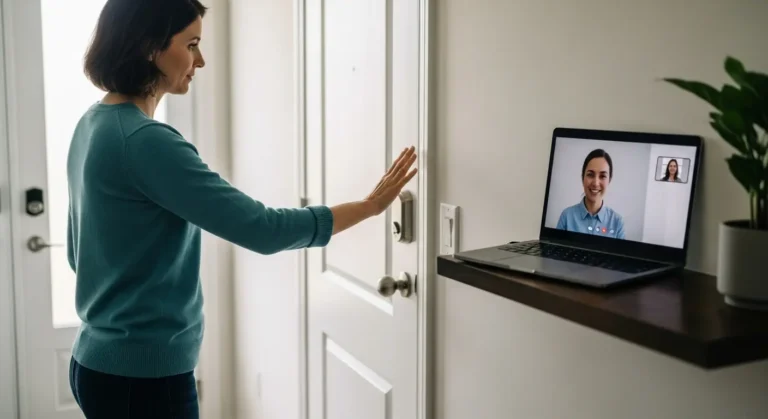OCD Intrusive Thoughts: Managing Them Through Virtual Therapy
Bottom Line: Virtual therapy has revolutionized OCD treatment, with peer-reviewed research published in the Journal of Medical Internet Research showing virtual ERP therapy achieving meaningful results in less than half the total therapist time compared with standard once-weekly outpatient treatment. For Ontario residents struggling with intrusive thoughts, virtual therapy offers immediate access to specialized care without geographical barriers.
Intrusive thoughts can feel overwhelming, especially when they’re part of Obsessive-Compulsive Disorder (OCD). If you’re experiencing unwanted, distressing thoughts that seem to take control of your mind, you’re not alone. Recent advances in virtual therapy have transformed how we treat OCD, making effective, evidence-based treatment more accessible than ever before.
Understanding Intrusive Thoughts in OCD
What Are Intrusive Thoughts?
According to the International OCD Foundation, obsessions are unwanted, intrusive thoughts, images, or urges that trigger intensely distressing feelings. Unlike passing worries or concerns that everyone experiences, OCD-related intrusive thoughts are unwelcome, involuntary thoughts, images, or unpleasant ideas that may become obsessions, are upsetting or distressing, and can feel difficult to manage or eliminate.
The National Institute of Mental Health (NIMH) defines these thoughts as fundamentally different from your true beliefs or desires. The obsessions and compulsions of OCD are ego-dystonic, meaning the thoughts go against your core values and character—you are distressed by their content and would prefer not to have them.
The Science Behind Intrusive Thoughts
Research shows that most people have unwanted intrusive thoughts from time to time, but in the context of OCD, these intrusive thoughts come frequently and trigger extreme anxiety, fear, and/or disgust that gets in the way of day-to-day functioning. Understanding this difference is crucial for recognizing when professional help might be beneficial.
Common Types of Intrusive Thoughts
Cleveland Clinic research identifies several categories of intrusive thoughts that are common in OCD:
Contamination and Safety Concerns
- Fear of germs, dirt, or contamination
- Worries about causing harm through negligence
- Concerns about personal safety or that of loved ones
Violent and Aggressive Thoughts The Mayo Clinic notes that violent intrusive thoughts or images of yourself doing something violent or abusive can make you worry that you’re a dangerous person. It’s crucial to understand that having these thoughts doesn’t mean you want to act on them.
Sexual and Relationship Obsessions
- Unwanted sexual thoughts or images
- Doubts about relationships or sexual orientation
- Intrusive sexual thoughts that may cause physical responses
Moral and Religious Concerns
- Excessive worry about being a good person
- Fear of having committed unforgivable acts
- Concerns about moral or religious purity
Symmetry and Order
- Need for things to be “just right”
- Obsessions about balance, symmetry, or completeness
Similar to anxiety disorders in general, these thought patterns can significantly impact daily functioning when they become persistent and distressing.
The OCD Cycle: How Intrusive Thoughts Take Control
Understanding the OCD cycle helps explain why these thoughts become so persistent:
- Intrusive Thought Appears: An unwanted thought, image, or urge enters your mind
- Misinterpretation: With OCD, you might believe that having an aggressive thought means you’re dangerous, even if you would never act on it
- Anxiety and Distress: The thought causes intense emotional discomfort
- Compulsive Response: You engage in behaviors or mental rituals to reduce the anxiety
- Temporary Relief: The compulsion provides short-term relief, reinforcing the cycle
- Strengthened Pattern: The cycle becomes more entrenched with each repetition
This cycle is often accompanied by other challenges, such as difficulty with emotion regulation, making comprehensive treatment approaches essential.
The Science Behind Virtual Therapy for OCD
Revolutionary Research Findings
Recent groundbreaking research has validated virtual therapy as not just an alternative, but potentially a superior treatment method for OCD. A comprehensive study published in the Journal of Medical Internet Research (JMIR), one of the most respected journals in healthcare research, examined the treatment outcomes of virtual exposure and response prevention (ERP) therapy for OCD.
The study analyzed over 3,500 adults with OCD, representing the largest reported treated cohort of patients with OCD to date. The findings are remarkable:
- Significant Symptom Reduction: Members experienced an average decrease in OCD symptoms, resulting in dramatic improvements in depression, anxiety, stress, and overall quality of life
- Time Efficiency: Results were achieved in less than half the total therapist time compared with standard once-weekly outpatient treatment, representing substantial monetary and time savings
- Large Effect Size: The effect size was large (g=1.0) and similar to studies of in-person ERP
Additional Research Validation
Recent 2025 research published in JMIR specifically examining virtual teletherapy for children and adolescents with OCD found that remote video telemedicine treatment showed noninferiority to traditional in-person treatment for OCD, anxiety, and depression in head-to-head studies.
Why Virtual Therapy Works So Well for OCD
Real-World Exposure Opportunities One of the vital advantages of remote treatment is that therapists can readily interact with people in the specific settings that most trigger their obsessional thoughts, images, or urges. This means you can practice coping strategies in your actual environment where OCD symptoms typically occur—something that’s often challenging in traditional office settings.
Accessibility and Consistency Virtual therapy eliminates geographical barriers and scheduling constraints that often prevent people from accessing specialized OCD treatment. This is particularly beneficial for Ontario residents who may not have local access to specialized OCD therapy.
Enhanced Treatment Efficiency Research consistently shows that virtual ERP therapy has been found to be more cost and time-effective, achieving meaningful results in approximately 11 hours of therapy compared to traditional therapy requiring over double that time.
Evidence-Based Virtual Treatment Approaches
Exposure and Response Prevention (ERP) Therapy
ERP remains the gold standard for OCD treatment, and virtual delivery has proven exceptionally effective. According to the American Psychiatric Association, this type of therapy helps you manage obsessive thoughts and compulsions by exposing you to triggers while preventing compulsive responses.
How Virtual ERP Works:
- Gradual Exposure: Working with your therapist, you’re gradually exposed to thoughts, images, or situations that trigger your obsessions
- Response Prevention: You practice resisting the urge to perform compulsions
- Real-Time Support: Your therapist guides you through exposures in your actual environment
- Skill Building: You develop tools to manage anxiety without relying on compulsions
Cognitive Behavioral Therapy (CBT) for Intrusive Thoughts
CBT has been extensively researched as an effective treatment for managing obsessive-compulsive disorder and intrusive thoughts. CBT exercises and techniques can help you change your relationship with intrusive thoughts and develop healthier coping mechanisms.
Key CBT Techniques for Virtual Sessions:
Thought Challenging and Cognitive Restructuring
- Learning to identify distorted thinking patterns
- Developing balanced, realistic responses to intrusive thoughts
- Understanding that thoughts are not facts or predictions
Mindfulness Integration Mindfulness and meditation techniques can be used in conjunction with other treatments, helping you redirect attention in a compassionate way toward the present moment rather than getting caught in anxious thought spirals.
Acceptance and Commitment Therapy (ACT)
ACT helps people identify their core values and commit to actions that align with those values, even in the presence of obsessions and compulsions. This approach teaches you to:
- Accept intrusive thoughts without fighting them
- Recognize thoughts as mental events, not commands
- Focus on value-based actions despite the presence of unwanted thoughts
Practical Coping Strategies You Can Use Today
Immediate Response Techniques
The “Maybe” Response According to mental health experts, rather than doing a compulsion, try reacting to intrusive thoughts in a way that doesn’t engage with them. For example, you could think or say to yourself, “maybe,” “that could be true, who knows,” or “ok, but I can’t control that.”
Thought Labeling Research suggests that reframing thoughts can reduce their emotional impact. Try replacing “What if…” thoughts with “I’ve just had a thought that…” This simple change gives the thought less meaning and power.
The 15-Minute Rule Dr. Jeffrey Schwartz’s four-step method includes the practice of delaying compulsions. When you feel the urge to perform a compulsion, set a timer for 15 minutes and engage in a different activity. This helps break the immediate connection between obsessions and compulsions.
Long-Term Management Strategies
Building Healthy Coping Mechanisms Research shows that journaling about your obsessions, compulsions, and triggers can help you process thoughts and feelings. It’s a valuable tool to use when triggered by an obsession or compulsion.
Physical Wellness Exercise is gaining recognition as important support for OCD management. A 2019 study found that people diagnosed with OCD who exercised reported improved mood, less anxiety, and reduced urges to engage in compulsions.
Mindfulness Practice Mindfulness helps you observe your thoughts and feelings without judgment while encouraging self-compassion and present-moment awareness. This complements the work done in emotion regulation therapy.
Advanced Coping Techniques
Uncertainty Training The International OCD Foundation notes that learning to tolerate uncertainty is crucial for OCD recovery. Research shows that most people have over 6,000 thoughts daily, and many report sometimes having bothersome thoughts. This normalization can help reduce the significance attached to intrusive thoughts.
Value-Based Living Focus on your core values and take actions aligned with them, regardless of what your intrusive thoughts suggest. This approach helps you build a meaningful life while managing OCD symptoms.
Understanding Virtual Therapy Success Rates
Research-Backed Effectiveness
The effectiveness of virtual OCD treatment is supported by substantial evidence:
- The effect size for OCD symptom severity reduction in virtual treatment (g=1.0, indicating a “large” effect size) is similar to that found in meta-analyses of controlled studies comparing ERP to psychological placebo
- Peer-reviewed research shows that virtual ERP therapy and in-app support between sessions can lead to meaningful results twice as fast as standard ERP therapy
- Multiple studies have demonstrated the effectiveness of virtual reality exposure and response prevention (VRERP) in treating OCD contamination subtypes
Treatment Timeline and Expectations
Initial Phase (Weeks 1-4)
- Comprehensive assessment and treatment planning
- Psychoeducation about OCD and intrusive thoughts
- Beginning basic ERP exercises
- Establishing therapeutic relationship
Active Treatment (Weeks 4-12)
- Intensive ERP practice
- Addressing specific intrusive thought patterns
- Building comprehensive coping skills
- Homework assignments and between-session practice
Maintenance Phase (Ongoing)
- Relapse prevention strategies
- Continued skill practice
- Periodic check-ins with therapist
- Long-term management planning
When to Seek Professional Help
Signs You Should Consider Virtual Therapy
Frequency and Intensity If intrusive thoughts occur multiple times daily and cause significant distress, professional help is recommended. The NIMH notes that when intrusive thoughts are related to an underlying condition like OCD, getting started with diagnosis and treatment is important, though it may take some time.
Impact on Daily Life When intrusive thoughts aren’t just a brief occurrence but something that takes up significant attention and interferes with work, relationships, or daily activities, professional evaluation is advisable.
Compulsive Responses What characterizes an intrusive thought as a component of OCD is how much emotional distress these thoughts cause and whether you try to alleviate that anxiety through compulsions.
Finding the Right Virtual OCD Specialist
Essential Qualifications
- Specialized training in OCD and ERP therapy
- Experience with virtual treatment delivery
- Understanding of intrusive thoughts and OCD subtypes
- Evidence-based treatment approach
What to Expect in Treatment Research indicates that one key to identifying an appropriate ERP therapist is whether they encourage you to engage in exposure exercises during sessions, helping you practice exposures outside of therapy as well.
Related Mental Health Considerations
Connection to Other Mental Health Conditions
OCD often co-occurs with other mental health conditions. Many people also experience:
- General anxiety disorders that may require integrated treatment approaches
- Depression that can develop secondary to OCD symptoms
- Challenges with life transitions that may trigger or worsen OCD symptoms
Impact on Relationships
OCD and intrusive thoughts can significantly affect relationships. Many people benefit from relationship therapy or interpersonal therapy to address how OCD impacts their connections with others.
Family and Support System Considerations
Family members and friends often benefit from education about OCD. Understanding the condition helps create a supportive environment that doesn’t inadvertently reinforce compulsive behaviors. Some families find family therapy helpful in learning how to support their loved one’s recovery.
Frequently Asked Questions
Is virtual therapy as effective as in-person treatment for OCD?
Research published in JMIR consistently shows that virtual therapy for OCD provides excellent treatment and is an effective option for individuals seeking therapy. Patients can reduce their OCD symptoms, leading to substantial improvements in depression, anxiety, stress, and overall quality of life. Multiple studies demonstrate non-inferiority or even superiority in some cases.
How long does virtual OCD treatment typically take?
According to NHS guidelines, people with fairly mild OCD usually need about 8 to 20 sessions of therapist treatment, with exercises done at home between sessions. If you have more severe OCD, you may need a longer course of treatment. Virtual treatment often achieves results faster due to increased accessibility and real-world practice opportunities.
Can virtual therapy help with all types of intrusive thoughts?
Yes, virtual therapy can effectively address all major categories of intrusive thoughts associated with OCD, including contamination fears, violent thoughts, sexual obsessions, and moral concerns. The key is working with a therapist specialized in your specific subtype and comfortable with virtual delivery methods.
What if I feel embarrassed about my intrusive thoughts?
The International OCD Foundation emphasizes that providers with experience in OCD and intrusive thoughts will recognize them for what they are, will not judge you, and will give you effective strategies. Specialized OCD therapists understand these experiences completely and provide a non-judgmental environment for healing.
How do I know if my thoughts are “normal” or if I need help?
Everyone has unwanted thoughts sometimes, but Mayo Clinic research indicates that OCD thoughts are typically more frequent, intense, and interfere with daily functioning. If thoughts are causing significant distress, taking up more than an hour per day, or leading to compulsive behaviors, professional evaluation is recommended.
Taking the Next Step: Accessing Virtual Therapy
Getting Started with Professional Treatment
If you’re ready to take control of your intrusive thoughts and break free from OCD’s cycle, virtual therapy offers an accessible, effective path forward. The research is clear: virtual ERP therapy for many people with OCD may be more effectively delivered in a face-to-face virtual setting than in person.
For residents of Ontario, specialized virtual therapy makes expert OCD treatment available regardless of your location. You can access evidence-based care from the comfort and safety of your own home, practicing skills in the very environment where your symptoms typically occur.
Why Choose Mental Wellness and Me
At Mental Wellness and Me, Laura Davidson, MSW, RSW, provides specialized virtual therapy for OCD and intrusive thoughts. With extensive experience in evidence-based treatments and a deep understanding of OCD’s complexities, she offers the expertise you need in a convenient, accessible format.
What Sets Our Approach Apart:
- Specialized training in OCD therapy and ERP techniques
- Comprehensive understanding of anxiety disorders and their treatment
- Person-centered, empowerment-based approach
- Virtual sessions that fit your schedule and comfort level
- Insurance coverage through most extended health benefit plans
Getting Started
You can learn more about our services and approach by visiting our about us page or reviewing our frequently asked questions. When you’re ready to take the next step, our contact page provides information on scheduling your initial consultation.
For additional mental health resources and insights, explore our blog, which includes articles on topics such as understanding anxiety disorders, managing emotion regulation, and the importance of daily self-care.
Conclusion: Hope and Healing Through Virtual Therapy
Intrusive thoughts associated with OCD can feel overwhelming and isolating, but you don’t have to face them alone. The breakthrough research in virtual therapy has opened new doors to effective, accessible treatment. Research consistently shows that learning to overcome intrusive thoughts requires multiple tools and techniques, including reframing, mindfulness, and evidence-based therapy approaches.
Remember that intrusive thoughts, no matter how disturbing, don’t define you or predict your actions. They’re symptoms of a treatable condition, and with the right support and evidence-based virtual therapy, you can learn to manage them effectively.
The journey to recovery starts with a single step. If you’re ready to reclaim your life from intrusive thoughts and OCD, virtual therapy offers a proven, accessible path forward. As mental health experts note, our lives are defined by the actions we choose to take, not by the electrical storm of thoughts that flicker through our minds.
Ready to start your journey toward freedom from intrusive thoughts? Contact Mental Wellness and Me today to schedule your initial virtual consultation and take the first step toward effective, evidence-based OCD treatment.
Additional Resources
For more information about OCD and mental health, consider these authoritative resources:




